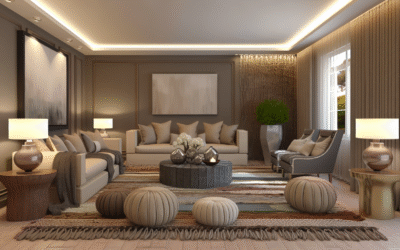
Introduction
Imagine walking into a space where the air feels lighter, thoughts come easier, and peace settles in like an old friend. This is the essence of Japandi minimalist style.
In this article, you will explore the tranquility offered by Japandi design—a harmonious blend of Japanese and Scandinavian aesthetics aimed at creating serene spaces.
We’ll cover:
- The core principles of Japandi style
- Key elements for achieving tranquility
- Practical tips for creating your own Japandi-inspired space
- FAQs to address common queries
- Next steps to implement
The Essence of Japandi Style
Combining the simplicity of Scandinavian design with the elegance of Japanese aesthetics, Japandi embodies harmony and functionality.
1. Core Principles
Japandi emphasizes minimalism, functionality, and a deep connection to nature. Here are its key principles:
- Simplicity: Less is more, focusing on essential elements.
- Natural Materials: Emphasis on wood, bamboo, and textiles.
- Functionality: Every item has a purpose and provides value.
2. Aesthetic Contrast
While Scandinavian design is often warm and inviting, Japanese design retains a more muted palette, creating a beautiful contrast.
Creating Tranquil Spaces
1. Colour Palettes
Colors play a crucial role in Japandi design. Consider neutral and earthy tones such as beige, gray, and soft greens.
2. Furniture Choices
Select low-profile furniture that enhances space rather than overwhelms. Look for pieces that are functional yet aesthetically pleasing.
3. Layering Textures
Utilize textiles like hemp or linen for softening surfaces. Adding elements like plush cushions and natural rugs can make the space cozy.
Practical Tips for Implementation
Now that you understand the principles and elements, here are actionable steps to create your own Japandi-inspired space.
1. Declutter
Start by removing unnecessary items. Keep what you cherish and donate the rest.
2. Focus on Quality Over Quantity
Invest in fewer but high-quality pieces. This reflects the core Japandi principle of functionality.
3. Integrate Natural Elements
Bring the outdoors in with potted plants and wooden features that enhance tranquility.
Comparison: Japandi vs. Other Minimalist Styles
Understanding how Japandi stands out compared to other minimalist styles can highlight its appeal.
| Style | Key Features | Emotional Impact |
|---|---|---|
| Japandi | Fusion of simplicity, functionality, natural materials | Serene, balanced, timeless |
| Scandinavian | Warmth, bright colors, cozy | Inviting, restful, communal |
| Modern Minimalism | Clean lines, monochrome colors, stark | Clinical, spacious, cold |
Case Studies
Let’s look at two examples where Japandi style was successfully implemented.
Case Study 1: Urban Apartment
In an urban setting, a couple transformed their small apartment using simple wood furniture and potted plants. The result? A pocket of tranquility amid the bustling city.
Case Study 2: Family Home
A family home adopted Japandi to foster a calming atmosphere, using neutral tones and multifunctional furniture. This approach not only improved aesthetics but also enhanced family interactions.
Frequently Asked Questions
What is Japandi style?
Japandi style is a design fusion of Japanese and Scandinavian aesthetics, focusing on minimalism, functionality, and natural materials.
How do I begin my Japandi journey?
Start by researching Japandi principles, decluttering your space, and selecting neutral color palettes.
Can I mix Japandi with other styles?
Yes! Japandi can harmonize beautifully with other minimalist styles to create a unique aesthetic.
What materials should I use?
Ideal materials include wood, bamboo, stone, and organic textiles like linen or cotton.
How does light affect Japandi interiors?
Natural light is highly valued, so maximizing windows and using soft lighting can enhance the tranquil feel.
Conclusion & Next Steps
To sum up, the Japandi minimalist style offers a serene approach to living spaces, allowing tranquility to flourish. Start by implementing the actionable tips outlined in this article, diving deeper into color choices and natural materials.
Feeling inspired? Transform your space today! Don’t forget to check out our related articles on interior design techniques and sustainable living.
Categories
- Accent Walls & Ceilings (61)
- Art Curation & Gallery (62)
- Bedding Style Trends (68)
- Bedroom Makeover (81)
- Bohemian & Eclectic Styles (58)
- DIY & Budget-Friendly Decor (63)
- Eco-Friendly Design (62)
- Furniture Care (71)
- Home Decor & Design Ideas (163)
- Home Wellness Spaces (59)
- Integrated Outdoor Living (67)
- Japandi Style (61)
- Kids and Nursery Decor (59)
- Living Room Decor (79)
- Mix & Match Techniques (73)
- Modern & Contemporary Design (66)
- Rug Sizing & Placement (73)
- Scandinavian Design Inspiration (12)
- Seasonal Home Decor (80)
- Small Space Solutions (73)
- Wall Art & Painting Tips (77)
Recent Comments
Archives
Product Gallery
-
Large Area Green Rugs for Bedroom Nordic Living Room Decoration Shaped Carpet Irregular Plush Lounge Rug Home Thick Washable Mat
Rated 5.00 out of 5$36.00 – $225.00Price range: $36.00 through $225.00 -
Nordic Style Rugs for Bedroom Morandi Living Room Decoration Carpet Large Area Geometry Lounge Rug Home Cloakroom Non-slip Mat
Rated 5.00 out of 5$26.00 – $387.00Price range: $26.00 through $387.00 -
Irregular Shapes Living Room Decoration Carpet Modern Style Rugs for Bedroom Home Thicken Plush Rug Fluffy Soft Lounge Floor Mat
Rated 4.85 out of 5$37.00 – $225.00Price range: $37.00 through $225.00














